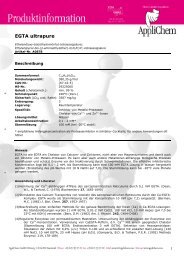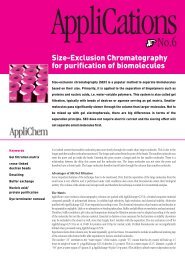Biological Buffers • AppliChem
Biological Buffers • AppliChem
Biological Buffers • AppliChem
You also want an ePaper? Increase the reach of your titles
YUMPU automatically turns print PDFs into web optimized ePapers that Google loves.
c o n t e n t s<br />
Introduction 2<br />
<strong>•</strong> The buffer concept <strong>•</strong> Buffer capacity <strong>•</strong> The pH value <strong>•</strong> The pKa value <strong>•</strong> <strong>Biological</strong> buffers<br />
Requirements of biological buffers 3<br />
<strong>•</strong> Solubility <strong>•</strong> Permeability <strong>•</strong> Ionic strength 3<br />
<strong>•</strong> Dependence of pKa value <strong>•</strong> Complex formation <strong>•</strong> Inert substances <strong>•</strong> UV absorption<br />
<strong>•</strong> Purity – simple method of manufacture <strong>•</strong> Costs 4<br />
<strong>•</strong> Overview of most important properties of buffers 4<br />
Recommendations for the setting of the pH value of a buffer 5<br />
<strong>•</strong> Temperature <strong>•</strong> Titration <strong>•</strong> Ionic strength <strong>•</strong> Buffer additives <strong>•</strong> pH meter control<br />
Criteria for the selection of a buffer 6<br />
<strong>•</strong> Selection of a buffer for the correct pH range <strong>•</strong> Determination of the pH optimum of an enzyme<br />
<strong>•</strong> Determination of the optimum buffer concentration <strong>•</strong> Application-dependent choice of buffer substance 6<br />
<strong>•</strong> Tris buffer: not always the best choice! 7<br />
<strong>•</strong> Volatile buffers <strong>•</strong> Buffer mixtures <strong>•</strong> <strong>Buffers</strong> for gel electrophoresis 8<br />
<strong>•</strong> Electrophoresis buffers 9<br />
Technical tips 10<br />
<strong>•</strong> How can microbial contamination of buffer solutions be prevented?<br />
<strong>•</strong> How can precipitation in concentrated TBE buffers be prevented?<br />
<strong>•</strong> What is the best way of obtaining solutions of the free acids of PIPES, POPSO and ADA?<br />
<strong>•</strong> What is the importance of water as a solvent?<br />
<strong>•</strong> (Disturbing) Effects of biological buffers in different assays 11<br />
<strong>•</strong> Concentration limits for buffers in protein assays 12<br />
<strong>•</strong> Saturated concentrations of buffers in solution at 0°C<br />
<strong>•</strong> “Old” buffers replaced by buffers with better properties<br />
Alphabetical list of biological buffers 13<br />
Temperature dependence of the pKa value of biological buffers (100 mM) 14<br />
pKa values of biological buffers (25°C, 100 mM), alphabetical list 16<br />
References 16<br />
Alphabetical product list of biological buffers supplied by <strong>AppliChem</strong> 17<br />
© 2008 <strong>AppliChem</strong> <strong>•</strong> <strong>Biological</strong> <strong>Buffers</strong> 1
















